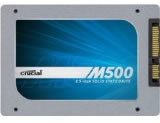
 When you install Windows on a Solid State Drive (SSD) , it not only boots and shuts down quicker, but applications load faster, and your computer will feel more responsive.
When you install Windows on a Solid State Drive (SSD) , it not only boots and shuts down quicker, but applications load faster, and your computer will feel more responsive.
SSD's have Serial ATA (SATA) data connectors, of which there are three versions (1, 2, or 3), that can transfer data at 1.5Gbps, 3Gbps or 6Gbps, respectively. If the SSD you purchase can use a SATA 3 port this will naturally provide the biggest speed benefits.
Fortunately it doesn't matter too much if your computer doesn't support SATA 3. SSD's are backwards compatible, and raw transfer speed isn't the only reason for a Solid State Drives' improved performance. More important is their much-reduced latency over conventional hard drives, as it takes considerably less time to access data from an SSD's flash memory than for a hard drive's mechanical arm to move itself into position.
There are a few disadvantages to be aware of, though. SSD's cost more, per GB of storage, than conventional hard drives. Plus, currently their capacities top out at around 500GB, which is well short of the current 4TB maximum for conventional hard drives.
It makes sense to keep Windows and your key applications on the SSD, which will benefit from the improved loading times, and large media collections on a separate hard drive.
 1. Unscrew the sides of your computer's case then remove them from the chassis. Some have latches holding the sides in place, which must be pushed open. Make sure you have clear access to the motherboard's SATA ports and hard drive bays.
1. Unscrew the sides of your computer's case then remove them from the chassis. Some have latches holding the sides in place, which must be pushed open. Make sure you have clear access to the motherboard's SATA ports and hard drive bays.
2. Place the SSD into its mounting bracket or a removable bay, line it up with the holes underneath, then screw it in. Position the mounting bracket into a spare 3.5-inch hard drive bay and secure it using holes at the side.
3. Connect the L-shaped end of a SATA cable to the SSD, and the other end to a spare SATA port (SATA 6Gbps ports are blue). Connect a SATA power cable to the SSD. For a fresh Windows installation (the best option), temporarily disconnect any other hard drives inside your PC.
4. Switch the PC on, insert your Windows DVD, then (typically) press Delete or F2 to enter the BIOS. All motherboards are different, but there should be a menu with a boot order option. Select your DVD drive to be first, save the settings then reboot.
5. Press a key when prompted to install Windows. The installer should start and, after a while, you should see a language screen. Choose English (United Kingdom) from the Time and currency format box, click Next, then click Install Now.
6. Tick the box to accept the license terms, then click Next. Choose a custom installation, then choose your SSD from the list. If you disconnected your other hard drives, it should be the only option. Click Next and installation will begin.
7. After the Windows installer has finished, it will reboot your computer. At this point, you may need to enter the BIOS and make the SSD the main boot device. The Windows installer will then run final setup, asking for a user name and computer name.
8. Create a user name and password, review your settings, then click Next. After you set your computer's network location, Windows will finalize your installation, display the Windows desktop, and begin installing software updates. Before you do anything else download a suitable anti virus program.
9. Switch off the computer, reconnect any other hard drives, then reassemble your case. Turn the computer back on,and enter the BIOS to make sure the SSD is the main boot device, and not your old drive, then reboot once again. Once Windows loads, you should let Windows install the rest of Microsoft's security and software updates.
Obviously, all your old files and Windows installation are still on your old drive. You can copy your documents, videos, music and pictures across to their respective folders on the SSD, but it's best to leave most of your files on the old hard drive to avoid using up the limited space on your SSD.
There are numerous ways to tell your new Windows installation that your documents and other files are on a different hard drive, but with Windows 7, the most elegant method is to use its libraries feature.
Create a folder on your hard disk (for example Documents). Right-click the folder in Explorer, scroll down to the Include in library option, then choose the Documents library from the list. Then copy any documents from the My Documents folder to the new one. You can do the same for movies, music and pictures, keeping your files close at hand without them residing on the SSD.
When it comes to programs, it makes sense to install those you use most on the SSD to benefit from its speed. When space becomes too tight, or you don't need the extra speed, install new programs on your old hard drive by specifying where to store the files during the installation process. If you leave the settings at their defaults, programs will always be installed to the same drive as Windows.
Read more articles about PC repairs, Web design & SEO